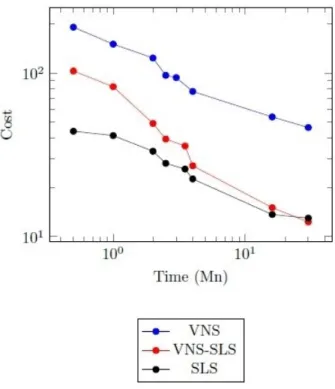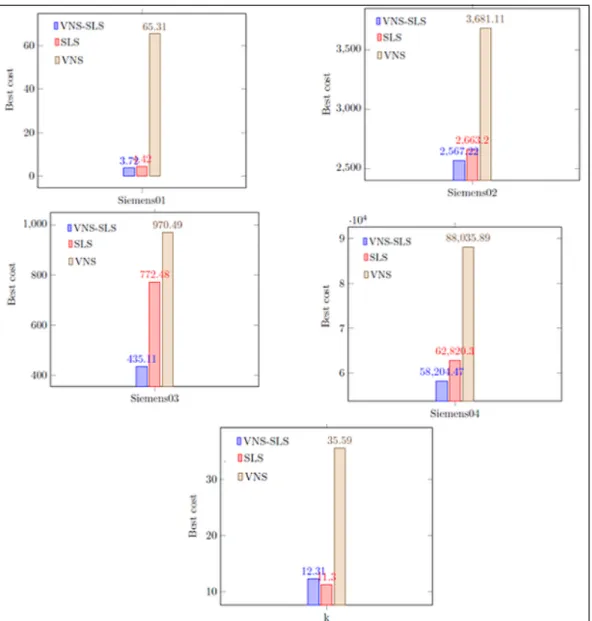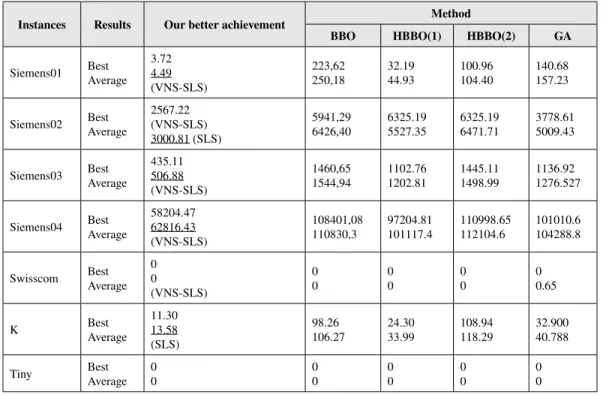HAL Id: hal-02098923
https://hal.archives-ouvertes.fr/hal-02098923
Submitted on 21 May 2020HAL is a multi-disciplinary open access archive for the deposit and dissemination of sci-entific research documents, whether they are pub-lished or not. The documents may come from teaching and research institutions in France or abroad, or from public or private research centers.
L’archive ouverte pluridisciplinaire HAL, est destinée au dépôt et à la diffusion de documents scientifiques de niveau recherche, publiés ou non, émanant des établissements d’enseignement et de recherche français ou étrangers, des laboratoires publics ou privés.
Interference Frequency Assignment Problem (MI-FAP)
in cellular networks,
Yasmine Lahsinat, Dalila Boughaci, Belaid Benhamou
To cite this version:
Yasmine Lahsinat, Dalila Boughaci, Belaid Benhamou. Three local search meta-heuristics for the Minimum Interference Frequency Assignment Problem (MI-FAP) in cellular networks,. Interna-tional Journal of Applied Metaheuristic Computing, IGI Global Publisher, 2019, 10 (3), pp.134-150. �10.4018/IJAMC.2019070107�. �hal-02098923�
DOI: 10.4018/IJAMC.2019070107
Copyright©2019,IGIGlobal.CopyingordistributinginprintorelectronicformswithoutwrittenpermissionofIGIGlobalisprohibited.
Three Local Search Meta-Heuristics
for the Minimum Interference
Frequency Assignment Problem
(MI-FAP) in Cellular Networks
Yasmine Lahsinat, LRIA-FEI- Computer Science Department, USTHB, BP 32 El-Alia Bab-Ezzouar, 16111, Algiers, Algeria Dalila Boughaci, LRIA-FEI- Computer Science Department, USTHB, BP 32 El-Alia Bab-Ezzouar, 16111, Algiers, Algeria Belaid Benhamou, AIX-Marseille University (AMU), LIS, Domaine Universitaire de Saint Jérôme Avenue Escadrille Normandie Niemen 13397 Marseille Cedex 20, Marseille, France
ABSTRACT Theminimuminterferencefrequencyassignmentproblem(MI-FAP)playsanimportantroleincellular networks.MI-FAPistheproblemoffindinganassignmentofasmallnumberoffrequenciestoalarge numberoftransceivers(TRXs)thatminimizestheinterferenceslevel.TheMI-FAPisknowntobe NP-Hard,thusitcannotbesolvedinpolynomialtime.Toremedythis,researchersusuallyusemeta-heuristictechniquestofindanapproximatesolutioninreasonabletime.Here,theauthorspropose threemeta-heuristicsfortheMI-FAP:avariableneighborhoodsearch(VNS)andastochasticlocal search(SLS)thatarecombinedtoobtainathirdandanewone,whichiscalledVNS-SLS.TheSLS methodisincorporatedintotheVNSprocessasasubroutineinordertoenhancethesolutionquality. Allthreeproposedmethodsareevaluatedonsomewell-knowndatasetstomeasuretheirperformance. TheempiricalexperimentsshowthattheproposedmethodVNS-SLSsucceedsinfindinggoodresults comparedtobothVNSandSLSconfirmingagoodbalancebetweenintensificationanddiversification. KeywoRdS
Assignment Problem, Local Search Methods, Minimum Interference Frequency, Radio Network, Stochastic Local Search (SLS), Variable Neighbourhood Search (VNS), VNS-SLS
1. INTRodUCTIoN Managingtheinterferencesinaradionetworkisarelevantissueconsideringthattheycanseverely damagethequalityofthecommunication.Inthispaper,weproposetostudythisissuewitharelated problemarisinginacellularradionetworknamelytheMinimumInterferenceFrequencyAssignment Problem.TheMI-FAPisawell-knownchallengingcombinatorialoptimizationproblem.Theissue istoassignafrequencytoeverytransceiverofthenetwork.Thedifficultiesappearduetothesetwo facts:theradioresourceisscarce,andthetremendousnumberoftransceiversdistributedoverthecell’s network.Therefore,itisunavoidabletoreusethefrequenciesmultipletimesbetweenthetransceivers
withinthenetwork.Butthiswillcauseinterferences.Indeed,whenstationsinclosegeographical areausethesameoradjacentfrequency,interferencesoccur.Toavoidthis,itisnecessarytoassign frequenciestoallthegeographicallycloseTRXsrespectingsomerequiredseparationconstraints. Inacellularradionetwork,theobjectiveisthentoassignfrequenciestoTRXswithinthedifferent cellsinsuchawaytominimizethetotalinterferences.Itisworthrecallingthesetwofacts:theTRXsin thesamecellscannotusethesamefrequencyandsomefrequenciesarenotoperationalinsomecells. Inthiswork,weconsiderthetwomajortypesofinterferences: • TheCo-channelinterferences:theseinterferencesappearwhentwogeographicallycloseTRXs usethesamefrequency(f); • TheAdjacent-channelinterferences:theseinterferencesappeariftwogeographicallycloseTRXs useneighboring(adjacent)frequencies(f+1,f-1). Intheeighties,HaledemonstratedthattheconsideredproblemisNP-hard.Heprovedthatthe MI-FAPisrelatedtothegraph-coloringproblem(Hale,1980).Therefore,thefrequencyassignment isanimportantandacomplextaskwhenplanningaradionetwork.Consideringthelimitedradio resource,thetremendousnumberofTRXs,aparticularattentionisgiventoachievethistaskavoiding oratleastminimizingtheinterferences. TheMI-FAPcannotbesolvedinpolynomialtime.Thus,usingmeta-heuristictechniquesoffers agoodcompromisetofindapproximatesolutionsfortheprobleminareasonabletime.Several meta-heuristicshavebeenproposedintheliterature.Thesemethodshaveshowntheirabilitytosolve variousproblemsthroughyears.Theyhadbeenusedtohandleschedulingproblem(Taghavifard, 2012),bioinformaticsproblem(Zemali,2016),bigdata(Benmounah,2017)andmanyotherproblems. Inthispaper,weproposethreemeta-heuristicsearchmethodsfortheMI-FAP.First,weadaptand studytheeffectivenessoftheVariableNeighborhoodSearch(VNS)fortheMI-FAP.Second,we proposeaStochasticLocalSearch(SLS)methodfortheMI-FAP.Finally,weproposetomergethese twolastmethodsinanewmethodwhichwecalledVNS-SLS.ThenewmethodVNS-SLS,includes theSLSmethodasalocalsearchsteptoattempttoenhancethesolutionquality.SinceVNShas gooddiversificationproperties,integratingSLSinit,willlogicallyresultinagoodbalancebetween intensificationanddiversification.WeexpectthenthatVNS-SLSwillhavethisfeaturewhichis essentialforproducinggoodresults.Wenotethatcollaborativeandhybridmethodsareworthwhile toensureasuccessofoptimizationtools.Therearetremendousworksthatusedhybridapproaches tohandleoptimizationproblems.Amongthem,wementionsomerecentworks(Wang,2017), (Boucheham,2017),(Abunaser,2015). Therestofthispaperisorganizedasfollows:section2givesabackgroundontheconsidered problem.Insection3,weproposeabriefliteraturereview.Section4explainsthekeycomponents ofthethreeproposedmethodsforsolvingtheMI-FAP.Section5presentssomeresultsofvarious testsandexperimentations.Finally,section6concludestheworkandgivessomefutureperspectives. 2. BACKGRoUNd WepresentinthissectiontheformaldescriptionoftheMI-FAPusedinthispaper.Letusconsidera radionetworkNcomposedofasetofcells:C = {C1, C2 …, Ci, …, Cnc},wherencisthenumberofcells. EachcellCihavingxiTRXsrequiresxidifferentfrequencies.Thenetworksmanageafixednumber
NFoffrequencies.Indeed,eachnetworkhasitsowninterval[Fmin, Fmax]ofoperationalfrequencies
with|Fmin- Fmax | = NF.Foreachcell,wehaveasetofoperationalfrequencies.Thismeansthatsome
cellscouldsufferfromsomeeventualrestrictionsandcannotusesomeofthefrequencies.Theco-channelandadjacentchannelconstraintsarerepresentedbytwomatricesdenotedIMcorespectively IMadjthataredefinedasfollows:
• IMco [nc][nc]:Containstheco-channelratebetweeneachpairofcellsofthenetwork.Anelement
IMco[i][j]oftheIMcomatrixcorrespondstotherateofco-channelinterferencewhenaTRXof
thecelljusesthesamechannel(f)thanthatoneofaTRXtofthecellI;
• IMadj [nc][nc]:Containstheadjacent-channelratebetweeneachpairofcellsofthenetwork.An
elementIMadj [i][j]oftheIMadjmatrixcorrespondstotherateoftheAdjacent-channelinterference
whenaTRXofthecelljusesanadjacentchanneltoaTRXtofthecelli.
ThesetwomatricesIMcoandIMadjcontaintheinteractionbetweencellswhentheTRXsusethe
sameoradjacentchannel.Theinterferencesareexpressedasrates(theirvaluesarebetween0and1). Wenotethat,area-basedandtraffic-basedaretwomainwaystorateinterferences.Inthispaper, weconsiderthearea-basedwaywheretheinterferencedescribestheaffectedareaandanelement
IMco[i][j](orIMadj [i][j])describesthepercentageofpixelsintheservicearea(Kuurne,2001)of
celliaffectedbythecellj. TheMI-FAPhandlesdvariableswhereeachvariablecorrespondstoafrequencyassignedtoa TRXiwithinacellj.Thevalueofafrequencyispickedfromtherange1toNF. TheMI-FAPisanoptimizationproblemthatconsistsinfindingafrequencyassignmentforthe dTRXsofthenetworkthatminimizesthecostfunctionproposedin(Kuurne,2001)andgivenin thefollowingformula: i i nc j j nc ij co ij adj Y IM i j Z IM i j = = = =
∑∑
× + × 0 0 (
)
×Wi (1) Theobjectivefunction(1)minimizestheoverallinterferencesthatequaltothetotalco-channel andadjacentchannelinterference,takingintoaccountthetrafficoveracell: • Wi:isaweightassociatedtotheCelli duetotheamountoftrafficcarriedonit;• Yij:isthenumberofdifferentpairsoftransceiversofthecellCiandCjthatoperatesonthe
samefrequency;
• Zij:isthenumberofdifferentpairsoftransceiversofthecellCiandCjthatoperatesonan
adjacentfrequency(f), (f+1/ f-1). 3. ReLATed woRKS Thefrequencyassignmentproblem(FAP)hasapracticalinterestinbothrealandtheoreticalaspects. Asthequalityoftheserviceofawirelesssystemdependshighlyontheoptimalmanagementofthe radioresource,theFAPisacoreprobleminthemodernwirelesssystems.Ithasrelevanceinmany fieldssuchasmilitaryandcivilapplications.TheFAPisachallengingcombinatorialoptimization problemthatdealswiththetuningofatremendousnumberoftransceivers,theirpositions,their frequenciesandtheinterferencesthatcouldoccur. ThepioneerwhointroducedthefrequencyassignmentproblemisMetzger.Hepublishedhis researchinthisfieldinthesixties(Metzger,1970).Sincethat,manyresearchersinvestigatedthis problem(Aardal,2007;Eisenblatter,2002;Leese,2002).SeveralformulationsoftheFAPhadbeen proposed.Thesurveypublishedin2007by(Aardal,2007)summarizedthedifferentformulations andobjectivesassociatedwiththeFAP.Hesaidthatingeneral,theobjectiveassociatedwiththe FAPistheminimizationofthenumberoffrequencies,therangeofthespectrum(span),orthetotal interferences.Therefore,dependingontheobjectivefunctiontooptimize,theFAPcanbeclassified asfollows(Aardal,2007):
• TheMinimumOrderFrequencyAssignment(MO-FAP)attempttominimizethenumberofthe frequenciesused; • TheMinimumSpanFrequencyAssignment(MS-FAP)attempttoreducetheintervalof frequenciesandgetassmallaspossiblethedifferencebetweenthehighestandthelowest frequency.Mostoftheearlyworksweredevotedtothisgoal(Mabed,2011); • TheMinimumBlockingFrequencyAssignment(MB-FAP)attempttoassignfrequenciesin suchawaythatnounacceptableinterferenceoccursandtheoverallblockingprobabilityofthe networkisminimized.Moreformallytheproblemisdefined(Eisenblätter,2000);
• The Minimum Interference Assignment Problem (MI-FAP) consists in minimizing the overallinterferences. Regardlessofitsformulation,theFAPrapidlygrewinpopularityandattractedmanyresearchers overthelastfiftyyears.WefocusinthisworkontheMI-FAPvariant.TheMI-FAPisaninteresting problemofoperationalresearcharisinginradionetworkswheretheissueistoassignfrequencies toeachTRXwiththeminimumlevelofinterferences.Hale(Hale,1980)modeledtheproblemasa graphcoloringproblemanddemonstratedthattheconsideredproblemisanNP-hard. Severalworksproposedthemeta-heuristicframeworktohandledifferentdatasetsoftheMI-FAP. AmongthemtheonesthatadoptedevolutionaryapproachessuchasEAsandAntColonyoptimization algorithms(ACO/EAs)proposedin2007(Luna,2007),ortheadaptationoftheculturalalgorithm (Alami,2008)publishedin2008.AnotherresearchstudiedtheparticleswarmtohandletheFAP (Bezuidenhout,2014).ArecentworkaddressedtheMI-FAPwithaHarmonySearch(Lahsinat,2017). Further,thereareworksthatadoptedsomesinglebasedsolutionmeta-heuristicmethodssuchasthe tabusearchalgorithmtosolvetheproblem(Dorne,1999),(MontemanniR.M.,2003),(Montemanni, 2010),(Lai,2015).Someotherworksthatdealtwiththeproblembyusingthesimulatedannealing principle(Duque-Anton,1993),(Beckmann,1999),(Colombo,2010).Otherworksadoptedhybrid methods(Luna,2011),(Mabed,2011)tosolvetheproblem.
4. THe PRoPoSed APPRoACHeS
Inthissection,wepresentthemainelementsoftheproposedapproaches.Wefirstdescribetheshared elements:thesolutionencoding,theobjectivefunctionmeasuringthequalityofthesolutionsandthe methodologyadoptedtoupdatethesolutionsmanipulatedbyallthetechniques.Thenwedescribe indetailthethreeproposedmethodsSLS,VNSandVNS-SLS.
4.1. The solution encoding
Animportantstepwhendesigningameta-heuristicisthesolutionencoding.Indeed,encodingrightly asolutioncaninfluencetheperformancesofthealgorithms.WeconsiderasasolutiontotheMI-FAPafrequencyplanthatminimizestheinterferences.AsolutionisexpressedbyavectorSolofd elementswithdthetotalnumberofTRXs.EachelementfromSolrepresentsthefrequencyassigned totheKthTRXofacelli.Eachfrequencyisrepresentedbyanumberfrom1toNF: Sol←{f1;f2….fd} 4.2. Updating Strategy Typically,fortheMI-FAP,theupdatingschemeconsistsinchangingthefrequencyassignedtothe TRXs.Thestrategyadoptedmustconsiderthesetwoimportantelementaryconditions:donotassign thesamefrequencytoTRXswithinthesamecellanddonotassignanon-operationalfrequency. Thus,weadoptanupdatingstrategythatguaranteesbeforeperforminganychangesoffrequency
thatthenewfrequenciesarevalidandtherequiredseparationbetweentheassignedfrequenciesto TRXsinthesamecellisrespected.
4.3. The objective Function
Thepurposehereistoreachasolutionthatwouldminimizethelevelofinterferences.Inotherwords, wemustfindanassignmentofthefrequencythatminimizestheobjectivefunctionencodedbythe formulaalreadygiveninEquation(1).
4.4. The Variable Neighborhood Search for MI-FAP
ThevariableNeighborhoodSearch(VNS)algorithmisasinglesolutionorientedmeta-heuristic proposedin1997byMladenovicandHansen(Mladenovic,1997).Sincethenvariousvariantsof VNSwereproposed,butthefundamentalideaisthesystematicchangeofneighborhoodcombined withalocalsearch.Thismethodconfirmeditsperformancetosolveseveraloptimizationproblems (Mladenovic,1997). InordertouseVNSalgorithm,wemustdefinesomeelements: 1. AsolutionthattheVNSmanipulates; 2. AneighborhoodstructurethatshouldbedefinedasNk(k=1…k=kmax); 3. Alocalsearchroutine; 4. Astoppingcondition,whichcouldbethemaximumnumberofiterationsorthemaximum CPUtime. InthespecificcaseofMI-FAP,theelementsoftheVNSaredefiningasfollows: • A Solution:Correspondstoafrequencyplan; • A Neighbor solution:Isasolutiongeneratedbyamovefromtheinitialsolution.Themoveis theoperatorthatmodifiestheassignmentofoneormoreTRXsintheinitialsolution,depending onthevalueofthekmax; • A Local Search:Weadoptedabasicone.Itstartswithaninitialsolution.Inthislocalsearch, wechoosetogeneratetheneighborbymodifyingtheconflictingelement:wefindthefrequency assignedtoaTRX,thatcausesthemostinterferenceswithitsneighborsandwechangeits frequencytothelessusedfrequency.Thenwetrytoimproveituntilastoppingcriterionismet. Thevariableneighborhoodsearch(VNS)processconsistsinthreemainphases:
• Initialization phase:Definesthesetofneighborhoodstructure Nkandgeneratestheinitial
solution x ;
• Main phase:(1)Setk :=1.(2)Untilk :=kmaxrepeatthefollowingsteps:a)Ashakingstep:
inthisstep,theprocessrandomlygenerates ′x ,withx xN k ′ ∈ .b)Alocalsearchstep:in thissteptheprocessappliesalocalsearchontheobtainedneighborx’toobtainalocally optimalsolution ′′x ; • Acceptance phase:Basedonthesolutionquality,decideseithertoaccepttheobtainedsolution ormovetothenextneighborhoodstructure.Formally:
◦ If ′′x isbetterthanthecurrentsolutionx set x := ′′x andrestarttheprocessfromthefirst neighborhoodstructureN1withx’’asaninitialsolution;
Fortheconsideredproblem,asolutioncorrespondstoafrequencyplan.Theinitialsolutionisgenerated randomly.Aneighborsolution x ' ofthesolution x ,isdefinedasasolutionwithkdecisionvariables havingdifferentvaluescomparingtox .FortheMI-FAP,thismeansthatbetweenthesolution x andits neighbor x ' wehavektransceiverswithdifferentfrequencies.Theneighboringsolutionisobtainedby applyingamovefromtheinitialsolution.Thismoveisanoperatorthatmodifiestheassignmentof frequenciestooneormoreTRXsintheinitialsolution x .Thenumberoffrequenciestomodifyinthe solutionx dependsonthecurrentvalueofNk.Thevalueofkmaxcorrespondstothemaximumnumber
ofdifferentfrequenciesassignedtoTRXsbetweenthesolutionx anditsneighborx ' . ThepseudocodeofVNSisgiveninAlgorithm1.
4.5. The Stochastic Local Search for MI-FAP
TheStochasticlocalsearchmethodsareefficientsearchtechniquestotacklealargerangeof combinatorialproblems.Theycoveredalargeclassofalgorithms.Wedistinguishbetweensimple iterativeimprovementmethodsandcomplexSLSmethods,suchasAntColonyOptimizationand EvolutionaryAlgorithms(HolgerH.Hoos,2004).HoosandStutzlementionthatmanyhigh-performanceSLSalgorithmsarebasedonacombinationofseveralsimplesearchstrategies, suchasIterativeBestImprovementandRandomWalk.TheconsideredSLSusedinthispaper probabilisticallymakesachoicebetweenarandomwalkandMin-Conflictsinspiredfromthe onedevelopedtohandletheoptimalwinnerdeterminationproblem(WDP)incombinatorial auctionspublishedin(Boughaci,2008). TheproposedSLStechniquefortheMI-FAPstartswithaninitialsolutionx andtriestofinda bettersolutioninthecurrentneighborhood.Theneighboringsolutionx ' ofthesolutionx isobtained bymodifyingthefrequencyassignedtoaselectedTRX.TheperturbedTRXisselectedaccording tooneofthetwofollowingcriteria:
Algorithm 1. The VNS for the MI-FAP
Require:aMI-FAPinstance,kmax,asolutionx,cost:theoverallvalueofinterferences.
Ensure:animprovedsolutionx
1:while(thestoppingcriterionisnotmet)do 2:k←1;
3:while(k≤kmax)do
4:x’←arandomneighborhoodsolution; 5:ApplyLocalSearchonx’toobtainx”; 6:ifcost(x”)<cost(x)then
7:x←x”;k←1; 8:else 9:k←k+1; 10:endif 11:endwhile 12:endwhile.
• ThefirstcriterionconsistsinchoosingtheTRXinarandomwaywithafixedprobabilitywp>0; • Thesecondcriterionconsistsinchoosingtheconflictingnode:wefindtheassignmentthat causesthemostinterferencewithitsneighborsandthenwemakeamoveonitbyassigning tothecorrespondingTRXthelessusedfrequency.Theprocessisrepeateduntilwemet stoppingcriterion. ThepseudocodeofSLSforMI-FAPisgiveninAlgorithm2.
4.6. A New Local Search Method VNS-SLS for MI-FAP
Inthissection,wepresentthemaincomponentsoftheproposednewapproachVNS-SLSthatcombines boththeVariableNeighborhoodSearch(VNS)andtheStochasticLocalSearch(SLS)methods.The VNS-SLSisaniterativeprocedure,whichstartsfromaninitialsolution x (i.eafrequencyassignment plan)generatedrandomly,andmovesstepbystepinthesearchspacewiththeaimtoimprovethe initialsolution.Ateachiteration,amovetoaneighborof x isperformed.Themoveconsistsin changingtheassignmentoffrequencytoaTRXselectedintheneighborhoodofx .Thepathbetween theinitialsolutionx andthegeneratedneighborisfixedwiththekmax.
TheSLSstepintheVNS-SLSmethodisalocalsearchprocessthatisusedtoimprovethe currentsolution.ThisSLSprocessusesaprobabilitytocontrolintensificationanddiversification. WeintegratedthisinVNSbecauseStochasticlocalsearch(SLS)algorithmsareamongthemost prominentandsuccessfultechniquesforsolvingseveralcomputationallydifficultproblemsinmany areasofcomputerscienceandoperationsresearch,includingpropositionalsatisfiability,constraint satisfaction,routing,andscheduling(Hoos,2004). Moreprecisely,inthiswork,weadoptedasimpleSLSasdescribedinsection4.5.Itallowstwo choices:(1)arandomwalkand(2)amin-conflictalgorithmusingaprobabilityparameter.Thesetwo choicesmakeabalancebetweenintensificationanddiversification.Indeed,thepuremin-conflict algorithmalonewillleadtoalocaloptimum.Thus,toavoidbeingstuckinalocaloptimum,weintroduce anoisethrougharandomwalk.Ittakesthegeneratedneighborof x andtriestoimproveit.
Algorithm 2. The SLS for MI-FAP
Require:AMI-FAPinstance,wp,asolutionx. Ensure:Animprovedsolutionx 1:while(Stoppingcriterionisnotmet)do 2:r←arandomnumberbetween0and1; 3:if(r<wp)then 4:pickarandomTRX 5:else 6:PickaconflictingTRX 7:endif 8:ModifyinxthefrequencyassignedtotheselectedTRXtoobtainx ' 9:x←x ' 10:endwhile
Thesolutionx '' obtainedattheendoftheSLSprocesswillbethecurrentsolutionintheVNS processwhenx '' isbetterthan x .Otherwise,theprocessrestartswiththenewneighborhood.The processisrepeateduntilastoppingcriterionismet. TheVNS-SLSmethodforMI-FAPissketchedinAlgorithm3. 5. CoMPUTATIoNAL eXPeRIMeNTS Inthissection,wepresentthecomputationalexperimentsachievedtocheckouttheperformances ofthethreemethods.TheexperimentsarecarriedonPChavinganIntelCorei5with4GBofRAM underWindows7.WedevelopedthemethodsusingtheJavalanguageprogramming.
5.1. The Considered datasets
Weevaluatedourmethodsonseveralpublicinstances.Duetothenon-deterministicnatureofthe threemethodsVNS,SLSandVNS-SLS,weconsider10runsbyinstanceandbyalgorithm.All instanceswerepickedupfromthecost259Benchmarksthatareavailableon(Eisenblätter,2000).We evaluatedVNS,SLS,andVNS-SLSonsevendifferentinstancesoftheconsideredproblemnamely: Tiny,K,Swisscom,Siemens1,Siemens2,Siemens3,andSiemens4.TheCOSTmeansEuropean UnionForumforcooperativescientificresearch(Eisenblatter,2002).TheCOST259containsseveral realisticradionetworkplanningscenarios. Wegivesomedetailsontheinstancestackled(Eisenblätter,2000): Siemens 01:Contains506cells,930TRXs,74differentfrequenciesavailablewithatotalnumberof 20417Co-channelinterferencesand10344adjacent-channelinterferencestobeavoided.
Algorithm 3. The VNS-SLS for MI-FAP
Require:anMI-FAPinstance,kmax,asolutionx,cost:istheoverallinterferences
Ensure:Animprovedsolutionx
1:while(Stoppingcriterionisnotmet)do 2:k←1;
3:while(k≤kmax)do
4:x '←arandomneighborhoodsolutionofx; 5:ApplySLSonx 'toobtain ’’x ;
6:ifcost(x '')<cost(x)then 7:x←x '';k←1; 8:else 9:k←k+1; 10:endif 11:endwhile 12:endwhile;
Siemens 02:Includes254cells,977TRXs,82differentavailablefrequencieswithatotalnumberof 30982Co-channelinterferencesand13970adjacent-channelinterferences. Siemens 03:Contains894cells,1623TRXs,55differentavailablefrequencieswithatotalnumber of63893Co-channelinterferencesand25105adjacentchannelinterferences. Siemens 04:Has760cells,2785TRXs,38differentavailablefrequencies,113658Co-channel interferences,and64341adjacentchannelinterferencestobeavoided. Swisscom:Composedby148cells,310TRXs,47availablefrequenciesandatotalnumberof535 adjacentchannelinterferences. K:264cells,267TRXs,49frequencies,27123Co-channelinterferences,and3199adjacentchannel interferencestobeavoided. Tiny:7cells,12TRXs,12frequencies,12Co-channelinterferencesconstraints,and9adjacent channelinterferencestobeavoided.
5.2. The Parameter Tuning
Forafaircomparisonamongthethreealgorithms,werunallthetechniquesusingthesameCPU time(1800seconds).Theadjustmentofthedifferentparametersoftheproposedapproachesisfixed byanempiricalstudy:
• TheVNSparameters:kmax=4,CPUtimeforthelocalsearchsub-routine(LS)=10seconds;
• TheSLSparameters:wp=0.25;
• TheVNS-SLSparameters:kmax=4,wp=0.25,CPUtimeforSLS=10seconds. 5.3. The effect of kmax
InordertoproposeanefficientVariableNeighborhoodSearchalgorithm,wededicateourfirstsets ofexperimentstofindtheadequatevalueofthekmaxparameterwhichisveryimportantintheVNS algorithm.Weexaminedfivepossiblevaluesofkmax=2,3,4,5,6,andachievesomeexperiments byusingtwoinstancesasshowninTable1.
TheresultspresentedinTable1indicatethatthebestsolutionsarefoundwhenusingakmax=4. Itisobviousthatincreasingthesizeoftheneighborhoodhasapositiveeffectontheperformances. Indeed,itbringsenoughdiversitythatavoidsbeingstuckinalocaloptimum.However,ifthesizeis toolargeitaffectsnegativelythequalityofthesolution.
5.4. The obtained Results
Table2givesthenumericalresultsofalloftheVNS,SLSandVNS-SLSmethodsonvariousinstances oftheMI-FAPproblem.Themean,thebest,theworstcostvalueandtheStandarddeviation(Std) resultsfoundbyeachmethodaregiven.Themeanvaluecorrespondstothesolutionqualityfound byeachalgorithmon10runs.Thebestandtheworstvaluesarerespectivelythebestandworst solutionsobtainedbyeachalgorithmon10runs.Thebestresults,intermofmeanandbestvalue, areinboldfont. TheresultsfromTable2showthatVNS-SLSandSLSmethodssucceedinfindinggoodresults foralmosttheconsideredinstances.TheyoutperformtheVNSalgorithmfortheSiemensandK
Table 1. Results obtained over two instances with different values of kmax
Instances VNS-1 (kmax = 2) VNS-2 (kmax = 3) VNS-3 (kmax = 4) VNS-4 (kmax = 5) VNS-5 (kmax = 6)
Siemens01 89.71 88.46 82.18 88.8 90
instances.WecanseethatthethreemethodsarecomparableontheTinyandSwisscominstances. Thisisduetothenatureofthesetwoproblemswhicharesmallinstances. FortheTinyinstance,weobservethatthethreemethodsfindtheoptimalsolution(i.ethebest=0). BothVNS-SLSandSLSfindtheoptimalsolutionforthe10performedrunsontheSwisscominstance. FortheKinstance,weobservethatSLSandVNS-SLSarecomparablewithaslightperformance infavoroftheSLSmethod.Forthisinstance,wedepictinFigure1theevolutionofthecostvalue overthe30minutesoftheexperimentforthethreemethods.ThecurveshowsthatVNS-SLSis fasterthanVNS.Wecanseethatforthesametime,theresultachievedbyVNS-SLSisbetterthan thestandardVNSwithalocalsearch.ThismeansthatthecombinationofSLSwithinVNSenhances theperformancesofVNSintermofboththetimeandthequalitypointofview.TheSLSallows escapingfromsomebadregionswhichleadstobetterresults. Forthedifficultinstances,theresultsobtainedbyVNS-SLSandSLSarecomparable.However, fortheSiemens1,Siemens3andSiemens4instances,wecanseeaslightperformanceinfavor ofVNS-SLS.Thestandarddeviationisrelativelysmall.Inordertoshowclearlytheperformance oftheproposedapproachesinsolvingMI-FAP,wedrawthebarplotsinFigure2.ThisFigure comparesthethreemethodsVNS,VNS-SLSandSLSintermofqualityofsolutionontheSiemens andKinstances.Wecanseethat,thetwomethodsSLSandVNS-SLSexploretheneighborsearch efficiently.ThisallowslocatinggoodqualitysolutioncomparingtotheVNS.WhenusingtheSLS
Table 2. The results obtained by the three proposed methods
Instances Statistical Features Method
VNS-SLS SLS VNS Siemens01 Best Mean Worst std 3.72 4.49 4.90 1.06 4.42 6.62 12.21 2.54 65.31 82.18 102.94 12.08 Siemens02 Best Mean Worst Std 2567.22 4988.30 8476.13 2774.46 2663.20 3000.81 4309.33 470.77 3681.11 5245.68 5643.34 525.57 Siemens03 Best Mean Worst Std 435.11 506.88 613.98 56.77 772.48 963.36 1189.63 120.78 970.49 1281.83 1939.33 420.59 Siemens04 Best Mean Worst Std 58204.47 62816.43 68462.09 3481.577 62820.30 67183.12 72804.13 2625.90 88035.89 91042.84 93194.87 1638.42 Tiny Best Mean Worst Std 0 0.14 1.46 0.46 0 0.08 0.48 0.15 0 0.08 0.48 0.18 Swisscom Best Mean Worst Std 0 0 0 0 0 0 0 0 0 0.34 1.33 0.46 K Best Mean Worst std 12.31 15.93 18.63 2.21 11.30 13.58 16.56 1.82 35.59 88.06 265.62 90.47
methodasalocalsearchintheVNSalgorithm,apositiveeffectandanenhancementisachievedin thequalitysolutioncomparedtothestandardVNSimplementedwiththelocalsearch.Indeed,the SLStechniquepermitstoenhancetheneighborsolutionsoftheVNSsearch.Moreprecisely,theSLS methodpermitstoensureagoodcompromisebetweenintensificationanddiversification.Thishelps themethodtoobtaingoodresults.Thediversificationphaseconsistsinselectingarandomneighbor solutionbyapplyingarandommove.Theintensificationphaseconsistsinselectinganeighborby changingtheconflictingnodeinthesolution. Further,wedrawFigure3toshowtheaverageresultsobtainedforalltheconsideredinstances. WecanseeinFigure3–athatbothSLSandVNS-SLSproducedresultsthatarebetterthanVNS foralltheSiemensinstances.WecanseeclearlythatthecombinationofSLSandVNSimprovethe resultsofVNSparticularlyforboththeinstancesSiemens01andSiemens03. FortheKinstance,wecanseeinFromFigure3-bthattheaveragesolutionsobtainedbybothSLS andVNS-SLSoutperformtheVNSmethod.TheSLScombinewellwiththeVNSitleadstoagood explorationofthesearchspace.ItenhancestheVNSsearchprocessallowingittogetbetterresults. FortheSwisscomandTinyinstances,thebehaviorofthethreemethodsisalmostthesame;they allsucceedtofindtheoptimalsolution. 5.5. Further Comparison Table3givesacomparisonwitharecentwork(LahsinatY.B.,2015)thatusedthesameformulation anddatasets.Theworkproposedthreehyper-heuristicstohandletheMI-FAP.Wenotethatthethree hyper-heuristicsmanagethesameheuristicsbutusedifferentmannertoselectthem.Thefirstone namelyHyper(1)isahyper-heuristicbasedonachoicefunctionwhichmeansthateachheuristichas aweightwhichevaluatesitsperformances.ThesecondnamelyHyper(2)usesarandomselectionof theheuristicsandthelastonenamelyHyper(3)isahybridonewhichusesaprobabilitytodecideto usethechoicefunctionorarandomchoice.
ThevaluesreportedinTable3forthedifferentapproachesaretheBestandaverageresults recordedfrom10runsforthesameoverallCPUtimeequalsto1800secondsforeachrun. WeobservethattheresultspresentedinTable3indicatethatourmethodsoutperformthose producedbythethreehyper-heuristicsforalltheconsideredinstances.Whencomparingtheresults recordedbytheVNS-SLSresultsandthehyper-heuristics,wecanobservethatfortheinstancesTiny andSwisscomthemethodsarecomparable. Toshowtheperformanceofourmethods,wegiveanothercomparisoninTable4. We compare our results with those of a Genetic algorithm and a Biogeography-based optimizationandtwohybridversionsoftheBiogeographyBasedoptimization:HBBO(1) andHBBO(2)(Lahsinat,2014).
ItisworthrecallingthatalltheresultsaregivenataCPUtimefixedto1800seconds.Itappears obviousfromtheresultspresentedinTable4thattheVNS-SLSandSLSproducedbetterresultsfor alltheSiemensandKinstances.FortheTinyandSwisscominstances,wecanobservethattheresults arethesame.WecanclaimthatSLScombinedwiththeVNSisagoodcombination.
Figure 3. The average results obtained on the considered instances
Table 3. A comparison with the hyper-heuristic approaches
Instances Results Methods
Our Better Achievement Hyper(1) Hyper(2) Hyper(3) Siemens01 BestAverage 3.724.49
(VNS-SLS)
47.70
88.78 21.2741.60 42.7949.04 Siemens02 BestAverage 2567.22(VNS-SLS)
3000.81(SLS)
4990,70
5815,79 5187.725422.59 4199.664672.32 Siemens03 BestAverage 435.11506.88
(VNS-SLS)
923,12
1409,34 884.641004.09 702.48787.99 Siemens04 BestAverage 58204.4762816.43
(VNS-SLS)
108232.4
110959.6 76968.7889047.31 87723.8391096.05
Swisscom BestAverage 0(SLS/VNS-SLS) 00 00 00
K BestAverage 11.3013.58
(SLS)
80.22
99.27 22.3043.99 100.94115.29
The different comparisons provided above shows that the VNS-SLS is better than VNSandSLSstandaloneforsomeinstances.Indeed,itimprovesdramaticallytheresults obtainedbyVNSonalltheinstancesandimprovessomeothermethodspublishedpreviously. TheresultsobtainedbySLSandVNS-SLSontheexperimentedbenchmarkslookstobe comparable.Theresultsaretoocloseforsomeinstances.However,thehybridalgorithm VNS-SLSlooksstableandrobusttodealwithgreatsizeinstancesoftheMI-FAP.Ithasa goodbalancebetweenintensificationanddiversificationandallowsabetterexplorationof thesearchspace. 6. CoNCLUSIoN Thefrequencyassignmentisanimportanttaskinthedesignofradionetworkwheretheobjective istofindanoptimalfrequencyplanthatpermitstoensureagoodqualityofservice.Inthispaper,a VariableNeighborhoodSearch(VNS),aStochasticLocalSearchandanewhybridsearchmethod thatcombinestheVariableNeighborhoodSearchwiththeStochasticLocalSearchareproposedfor theMI-FAP.Theperformancesoftheproposedalgorithmsareevaluatedandcomparedusingwell-knowndatasets. TheexperimentsconductedshowthebenefitsoftheSLSasalocalSearchintheVNSprocess. Theresultsareveryencouragingandthenewhybridmethodsucceedsinfindinggoodresultsfor theconsideredbenchmarks.Thishybridmethodisstillinitscradleandmanypossibilitiesandideas arepossibletoenhanceitandavoidallthehindrancesthatlimititsperformance.Asaperspective, firstitwouldbeinterestingtoseeifwecanobtainbetterresultsbyincreasingthesearchtimefor theproposedapproaches.WealsoplantoexploreotherformsofSLSthatcouldbecombinedwith theVNS.Anotherpointthatcouldimproveourworkistoseeifthedifferentstepsintheproposed methodscouldbelaunchedinparallel.
Table 4. Comparison with BBO, HBBO(1), HBBO(2) and GA
Instances Results Our better achievement Method
BBO HBBO(1) HBBO(2) GA
Siemens01 BestAverage 3.724.49 (VNS-SLS)
223,62
250,18 32.1944.93 100.96104.40 140.68157.23 Siemens02 BestAverage 2567.22(VNS-SLS)
3000.81(SLS)
5941,29
6426,40 6325.195527.35 6325.196471.71 3778.615009.43 Siemens03 BestAverage 435.11506.88
(VNS-SLS)
1460,65
1544,94 1102.761202.81 1445.111498.99 1136.921276.527 Siemens04 BestAverage 58204.4762816.43
(VNS-SLS)
108401,08
110830,3 97204.81101117.4 110998.65112104.6 101010.6104288.8 Swisscom BestAverage 00
(VNS-SLS) 0 0 00 00 00.65 K BestAverage 11.3013.58 (SLS) 98.26 106.27 24.3033.99 108.94118.29 32.90040.788
ACKNowLedGMeNT
Theauthorswouldliketothanktheeditorandreviewersforcarefulreading,constructivecomments andvaluablesuggestionsthathelpedustoimprovethepaper.
AlsotheauthorswouldliketomentionthatthisworkwassupportedbythePHCTassili Project-17MDU987.
ReFeReNCeS
Aardal,K.,vanHoesel,S.P.M.,Koster,A.M.C.A.,Mannino,C.,&Sassano,A.(2007).Modelsandsolution techniquesforfrequencyassignmentproblems.Annals of Operations Research,153(1),79–129.doi:10.1007/ s10479-007-0178-0
Abunaser,A.M.,&Alshattnawi,S.(2015).Hybridizingartificialbeecolonyalgorithmwithmulti-parent crossoveroperator.International Journal of Applied Metaheuristic Computing,6(2),18–32.doi:10.4018/ IJAMC.2015040102
Alami,J.E.(2008).Usingculturalalgorithmforthefixed-spectrumfrequencyassignmentproblem.The Journal
of Mobile Communication,2(1),1–9.
Beckmann,D.K.(1999).Frequencyplanningwithrespecttointerferenceminimizationincellularradionetworks. Benmounah,Z.M.,Meshoul,S.,&Batouche,M.(2017).Scalabledifferentialevolutionaryclusteringalgorithm forBigDatausingmap-reduceparadigm.International Journal of Applied Metaheuristic Computing,8(1), 45–60.doi:10.4018/IJAMC.2017010103
Bezuidenhout,W.(2014).Optimisingthefrequencyassignmentproblemutilizingparticleswarmoptimisation [Doctoraldissertation].UniversityofJohannesburg.
Boucheham,A.,&Batouche,M.(2017).Hybridwrapper/filtergeneselectionusinganensembleofclassifiers andPSOalgorithm.International Journal of Applied Metaheuristic Computing,8(2),22–37.doi:10.4018/ IJAMC.2017040102
Boughaci,B.B.(2008).Stochastic Local Search for the Optimal Winner Determination Problem in Combinatorial
Auctions. In International Conference on Principles and Practice of Constraint Programming (pp. 593-597).
Springer. Colombo,G.A.,&Allen,S.M.(2010).AcomparisonofproblemdecompositiontechniquesfortheFAP.Journal of Heuristics,16(3),259–288.doi:10.1007/s10732-009-9116-4 Dorne,R.H.(1999).Tabusearchforgraphcoloring,T-coloringsandsetT-colorings.InMeta-heuristics(pp. 77-92).Boston,MA:Springer. Duque-Antón,M.,Kunz,D.,&Ruber,B.(1993).Channelassignmentforcellularradiousingsimulatedannealing.
IEEE Transactions on Vehicular Technology,42(1),14–21.
Eisenblatter,A.G.(2002).Frequencyplanningandramificationsofcoloring.InDiscussionsMathmatcaeGraph Theory(pp.51-88).
Eisenblätter,A.K.(2000,June9).COST259-WirelessFlexiblePersonalizedCommunications.Retrievedfrom http://fap.zib.de/problems/COST259/
Hale,W.(1980).Frequencyassignment:Theoryandapplications.InProceedings of the IEEE(pp.1497–1514). Hansen,P.,&Mladenović,N.(1997).Variableneighborhoodsearchforthep-median.Location Science,5(4), 207–226.
Holger,H.,&Hoos,T.S.(2004).Stochastic Local Search: Foundations and Applications.Elsevier.
Kuurne,A.(2001).Mobile Measurement based Frequency Planning in GSM Network.HelsinkiUniversityof Technology.
Lahsinat,Y.(2014).ImprovingBiogeographyBasedOptimizationbyUsingStochasticLocalSearchandSolving MI-FAPProbleminGSMNetworks.InBasedOptimization(ICSIBO’2014)(pp.112-119).Mulhouse. Lahsinat,Y.B.(2015).Trois hyper-heuristiques pour le problème d’affectation de fréquence dans un réseau
cellulaire. In 11th Journées Francophones de programmation par contraintes(pp.184–193).Bordeaux:JFPC.
Lahsinat,Y.B.(2017).HarmonySearchBasedAlgorithmsfortheMinimumInterferenceFrequencyAssignment Problem.InInternational Conference on Harmony Search Algorithm (ICHSA2017)(pp.179–189).Bilbao, Spain:Springer.doi:10.1007/978-981-10-3728-3_18
Yasmine Lahsinat is a PhD student in computer science. She currently works at the Department of Informatics, University of Science and Technology Houari Boumediene. Yasmine does research on combinatorial optimization, meta-heuristics and Artificial Intelligence. Yasmine is a member of the LRIA Artificial Intelligence Laboratory at the USTHB University.
Dalila Boughaci is a Full Professor in Computer Science at the University of Science and Technology USTHB (Algeria). She got her PhD from the University of Aix-Marseille (France) in 2008 and her “Habilitation” Post-doctoral diploma from USTHB University in 2009. Dalila Boughaci earned a Bachelor of Engineering degree in Computer Science from Algiers University, MS degree in Computer Science and her second PhD in programming systems from the University of Sciences and Technology, Beb-Ezzouar, Algiers in 1997, 2001 and 2008, respectively. Boughaci’s current research interests are in the areas of data mining, deep learning, evolutionary computation, artificial intelligence, meta-heuristics, multi-agent systems, network security, credit scoring and e-commerce. She has published several papers on these research topics in journals and conferences and directed several PhD, MS and BS students’ projects. Boughaci has taught Parallel computing, machine learning, Web service, Object Oriented Programming, algorithmic, software engineering, databases, Java, Agents and programming languages at Algiers, and served on several program committees. Boughaci is a member of the LRIA Artificial Intelligence Laboratory at the University of Algiers. She is the head of the research team: Optimization, Reasoning and Application of the LRIA Laboratory.
Belaid Benhamou is currently a Research Professor at Aix-Marseille University. He received his mathematical bachelor in 1983, his engineering degree in computer science in 1988 and his PhD in computer science in 1993 at the Aix-Marseille I University. He obtained an Assistant Professor job at the University of Aix-Marseille I in 1995 and in 2001, he obtained his Habilitation thesis after which he got a national qualification for Full University Professor. His research activities are in the field of artificial intelligence: constraint solving, logic and automated theorem proving, logic programming, non-monotonic reasoning, meta-heuristics and combinatorial optimization and data mining. He published over 120 articles and has supervised several doctoral theses on these areas.
Lai,X.H.,&Hao,J.-K.(2015).Pathrelinkingforthefixedspectrumfrequencyassignmentproblem.Expert
Systems with Applications,42(10),4755–4767.doi:10.1016/j.eswa.2015.01.025
Leese,R.H.(2002).Methods and Algorithms for Radio Channel Assignment.Oxford:OxfordUniversityPress. Luna,F.B.(2007).ACOvsEAsforsolvingareal-worldfrequencyassignmentprobleminGSMnetworks. In 9th Annual Conference on Genetic and Evolutionary Computation (pp. 94–101). London: ACM. doi:10.1145/1276958.1276972
Luna,F.E.-G.-R.,Estébanez,C.,León,C.,Chaves-González,J.M.,Nebro,A.J.,Aler,R.,&Gómez-Pulido, J.A.et al.(2011).Optimizationalgorithmsforlarge-scalereal-worldinstancesofthefrequencyassignment problem.Soft Computing,15(5),975–990.doi:10.1007/s00500-010-0653-4
Mabed,H.,Caminada,A.,&Hao,J.K.(2011).Genetictabusearchforrobustfixedchannelassignmentunder dynamictrafficdata.Computational Optimization and Applications,50(3),483–506.
Metzger,B.H.(1970).Spectrummanagementtechnique.InProceedings of the 38th National ORSA Meeting, Detroit,MI.
Montemanni,R.,Moon,J.N.,&Smith,D.H.(2003).Animprovedtabusearchalgorithmforthefixed-spectrum frequency-assignmentproblem.IEEE Transactions on Vehicular Technology,52(4),891–901.
Montemanni,R.S.,&Smith,D.H.(2010).Heuristicmanipulation,tabusearchandfrequencyassignment.
Computers & Operations Research,37(3),543–551.doi:10.1016/j.cor.2008.08.006
Taghavifard,M.T.(2012).SchedulingcellularmanufacturingsystemsusingACOandGA.International Journal
of Applied Metaheuristic Computing,3(1),48–64.doi:10.4018/jamc.2012010105
Wang,Y.,&Xu,N.(2017).Ahybridparticleswarmoptimizationmethodfortravelingsalesmanproblem.
International Journal of Applied Metaheuristic Computing,8(3),53–65.doi:10.4018/IJAMC.2017070104
Zemali,E.,&Boukra,A.(2016).Usingabio-inspiredalgorithmtoresolvethemultiplesequencealignment problem.International Journal of Applied Metaheuristic Computing,7(3),36–55.doi:10.4018/IJAMC.2016070103





